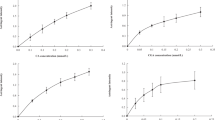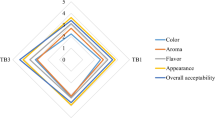Abstract
Epigallocatechin gallate (EGCG) and flavonols are important phenolic compounds in green tea. These compounds are sensitive to thermal condition and their structural alteration results in making browning the green tea infusion. This study aimed to research the interaction between EGCG and flavonols during thermal infusion. EGCG and flavonols model solutions were prepared based on concentration in green tea infusion, and their colors appearance and attributes were analyzed in 10 h by thermal treatment. Results showed that kaempferol, quercetin, and myricetin accelerated the oxidation of EGCG and made the model solution browning. HPLC analysis revealed there was an obvious shift of a broaden peak in the mixed model solution of EGCG and flavonols after thermal treatment. This broaden peak was further purified on HPLC and solid phase extraction methods to yield colored complexes. The complexes showed the maximal absorption around 424, 442, and 482 nm. MS/MS analysis revealed that the complexes possessed of three components those were consisted of the interaction between EGCG and myricetin. These results indicated that the interaction between EGCG and flavonols might form complexes during thermal treatment, The complexes were contributed to make green tea infusion browning.





Similar content being viewed by others
References
Bailey RG, Nursten HE, Mcdowell I (1993) The chemical oxidation of catechins and other phenolics: a study of the formation of black tea pigments. J Sci Food Agric 63:455–464
Bazinet L, Araya-Farias M, Doyen A, Trudel D, Têtu B (2010) Effect of process unit operations and long-term storage on catechin contents in EGCG-enriched tea drink. Food Res Int 43:1692–1701
Chen Z, Zhu QY, Tsang D, Huang Y (2001) Degradation of green tea catechins in tea drinks. J Agric Food Chem 49:477–482
Francia-Aricha EM, Guerra MT, Rivas-Gonzalo JC, Santos-Buelga C (1997) New anthocyanin pigments formed after condensation with flavanols. J Agric Food Chem 45:2262–2266
Helliwell WK (2001) Determination of flavonols in green and black tea leaves and green tea infusions by high-performance liquid chromatography. Food Res Int 34:223–227
Hughes M, Burns J, Lean ME, Matthews D, Crozier A (1998) Survey of the free and conjugated myricetin and quercetin content of red wines of different geographical origins. J Agric Food Chem 46:368–375
Jiang XL, Liu YJ, Li WW, Zhao L, Meng F, Wang Y, Tan HR, Yang H, Wei CL, Wan XC, Gao LP, Xia T (2013) Tissue-specific, development-dependent phenolic compounds accumulation profile and gene expression pattern in tea plant (Camellia sinensis). PLoS ONE 8:e62315
Jiang H, Engelhardt UH, Thräne C, Maiwald B, Stark J (2015) Determination of flavonol glycosides in green tea, oolong tea and black tea by UPLC compared to HPLC. Food Chem 183:30–35
Kumar PV, Basheer S, Ravi R, Thakur MS (2011) Comparative assessment of tea quality by various analytical and sensory methods with emphasis on tea polyphenols. J Food Sci Tech 48:440–446
Li N, Taylor LS, Ferruzzi MG, Mauer LJ (2013) Color and chemical stability of tea polyphenol (−)-epigallocatechin-3-gallate in solution and solid states. Food Res Int 53:909–921
Liang YR, Ye Q, Jin J, Liang H, Lu JL, Du YY, Dong JJ (2008) Chemical and instrumental assessment of green tea sensory preference. Int J Food Prop 11:258–272
Liu JW, Hong-Yu LI, Shi RJ, Guo YY (2010) Determination of content of EGCG and ECG in tea polyphenols by HPLC. Sci Technol Food Ind 31:372–374
Maini S, Hodgson HL, Krol ES (2012) The uva and aqueous stability of flavonoids is dependent on B-ring substitution. J Agric Food Chem 60:6966–6976
Napolitano JG, Gödecke T, Lankin DC, Jaki BU, Mcalpine JB, Chen SN, Pauli GF (2014) Orthogonal analytical methods for botanical standardization: determination of green tea catechins by qNMR and LC–MS/MS. J Pharm Biomed Anal 93:59–67
Neilson AP, Hopf AS, Cooper BR, Pereira MA, Bomser JA, Ferruzzi MG (2007) Catechin degradation with concurrent formation of homo- and heterocatechin dimers during in vitro digestion. J Agric Food Chem 55:8941–8949
Polyakov VV (1999) Chemical modification of the natural flavonoid myricetin. Chem Nat Compd 35:21–28
Price KR, Rhodes MJC, Barnes KA (1998) Flavonol glycoside content and composition of tea infusions made from commercially available teas and tea products. J Agric Food Chem 46:2517–2522
Roberts EAH, Cartwright RA, Wood DJ (1956) The flavonols of tea. J Sci Food Agric 7:637–646
Sang S, Lee M, Zhe H, Ho CT, Yang CS (2005) Stability of tea polyphenol (−)-epigallocatechin-3-gallate and formation of dimers and epimers under common experimental conditions. J Agric Food Chem 53:9478–9484
Seto R, Nanjo FHY, Nakamura H (1997) Preparation of epimers of tea catechins by heat treatment. Biosci Biotechnol Biochem 61:1434–1439
Sommano S, Kanphet N, Siritana D, Ittipunya P (2011) Correlation between browning index and browning parameters during the senesence of longan peel. Int J Fruit Sci 11:197–205
Tsanova-Savova S, Ribarova F (2002) Free and conjugated myricetin, quercetin, and kaempferol in Bulgarian red wines. J Food Compost Anal 15:639–645
Ujihara T, Hayashi N (2009) Hypochromic effect of an aqueous monoglucosyl rutin solution caused by green tea catechins. Biosci Biotechnol Biochem 73:2773–2776
Wang H, Helliwell K (2000) Epimerisation of catechins in green tea infusions. Food Chem 70:337–344
Wang LF, Kim DM, Lee CY (2000) Effects of heat processing and storage on flavanols and sensory qualities of green tea beverage. J Agric Food Chem 48:4227–4232
Wang LF, Kim DM, Lee CY (2002) Interaction of flavanols in green tea extract during heat processing and storage. Food Sci Biotechnol 11:4227–4232
Wang LF, Park SC, Chung JO, Baik JH, Park SK (2004) The compounds contributing to the greenness of green tea. J Food Sci 69:S301–S305
Wang M, Yang R, Zhao W (2008) Effects of heat and pulsed electric fields on bioactive components and color of green tea infusions. Inter J Food Eng 4:99–107
Wei Y, Chen P, Ling T, Wang Y, Dong R, Zhang C, Zhang LJ, Han MM, Wang DX, Wan XC, Zhang JS (2016) Certain (–)-epigallocatechin-3-gallate (EGCG) auto-oxidation products (EAOPs) retain the cytotoxic activities of EGCG. Food Chem 204:218–226
Wu C, Xu H, Héritier J, Andlauer W (2012) Determination of catechins and flavonol glycosides in chinese tea varieties. Food Chem 132:144–149
Xie HQ, Wang GG, Guo JS (1993) Effects of pH and temperature on reaction kinetics of catechins in green tea infusion. Biosci Biotechnol Biochem 57:907–910
Xu JZ, Leung LK, Huang Y, Chen ZY (2003) Epimerisation of tea polyphenols in tea drinks. J Sci Food Agric 83:1617–1621
Zhang Y, Chen H, Zhang N, Ma L (2015) Antioxidant and functional properties of tea protein as affected by the different tea processing methods. J Food Sci Technol 52:742–752
Acknowledgements
This study was financially supported by National Nature Science Foundation of China for Young Scholar (Project No: 31101355) and Anhui Provincial Key S&T Special Projects (15czz03116, 1505072038). The authors also sincerely thank Dr. Zheng Li from Food Science and Human Nutrition Department at the University of Florida for the help on revising and editing the manuscript.
Author contribution
Q. Dai and T. Xia designed and supervised the study. Y. He performed the experiment and analyzed data. Q. Dai and Y. He interpreted data and drafted the manuscript. J. Wang, S. Wang, and Y. Yang helped on the experiment preparation and participated in data interpretation. C. Ho helped to the data interpretation.
Author information
Authors and Affiliations
Corresponding authors
Ethics declarations
Conflicts of interest
All the authors declare no conflict of interest.
Rights and permissions
About this article
Cite this article
Dai, Q., He, Y., Ho, CT. et al. Effect of interaction of epigallocatechin gallate and flavonols on color alteration of simulative green tea infusion after thermal treatment. J Food Sci Technol 54, 2919–2928 (2017). https://doi.org/10.1007/s13197-017-2730-5
Revised:
Accepted:
Published:
Issue Date:
DOI: https://doi.org/10.1007/s13197-017-2730-5




